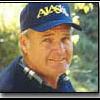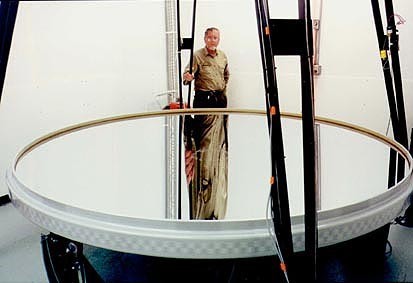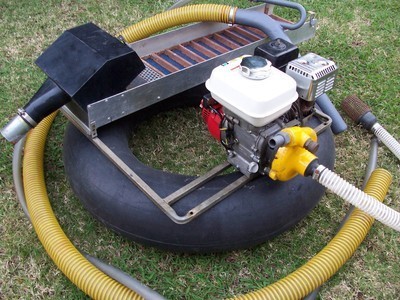-
Posts
248 -
Joined
-
Last visited
-
Days Won
1
Content Type
Forums
Detector Prospector Home
Detector Database
Downloads
Everything posted by Jim_Alaska
-

Golden Grams Of Goodness: Nugget Shooting Stories
Jim_Alaska replied to Lanny's topic in Detector Prospector Forum
No one tells them better than Lanny; I've been reading his stories for years. -

Big Flotilla Of Illegal Gold Dredgers In Brazil
Jim_Alaska replied to Erik Oostra's topic in Detector Prospector Forum
This is a common misconception and dangerously not true. Hg (Mercury) can and will vaporize at room temperature and even lower. While inhaling it while cooking off the Hg is the fastest way to contaminate yourself, just breathing naturally when Hg is present is extremely dangerous. I worked with Hg for many years in a controlled, clean room environment and have first hand, scientifically trained experience with Hg, it effects and uses. It does not belong in the hands of untrained people in any capacity, especially mining. This is a picture of 420 pounds of elemental Mercury in a controlled environment. -
At $92,000 USD, I don't think they will be selling a lot of them. It would make a great prospecting vehicle for any kind of prospecting or exploration.
-

Plantar Fasciitis, Or🤬!! My Heel Really Hurts!!
Jim_Alaska replied to Joe D.'s topic in Detector Prospector Forum
I developed this condition in 2005, while moving from Alaska to Oregon. Had to buy a cane to be able to walk. When I got to Oregon a friend told me that a friend of his also got what seemed to be the same thing I had. He said that his friend heard about talking Coral Calcium for it and it worked. So I got some and within a few days it was gone and has never returned. -

In Need Of A Picture
Jim_Alaska replied to Jim_Alaska's topic in Gold Panning, Sluicing, Dredging, Drywashing, Etc
No big rush or even need Steve. I have all the parts and it is assembled. My biggest problem in the beginning was that I had an extra part that I thought went with this unit, but it turned out to be for a larger dredge. Once I saw a picture of it assembled I realized that I had one part too many and it of course didn't line up with anything on the dredge. -
I have been privileged to see Steve's "scrape and detect" method first hand. It was many years ago at Crow Creek in Alaska. He graciously let me go over the ground first, but walked close enough behind me that I could hear his detector go off on nuggets I had missed. Back then he was also using a short handle rake to scrape, so he stops and scraps and they just keep popping up. He is second to none at finding whole "patches" of nuggets.
-

In Need Of A Picture
Jim_Alaska replied to Jim_Alaska's topic in Gold Panning, Sluicing, Dredging, Drywashing, Etc
Thanks to all that contributed to this request. I should have included the information that I have all the parts, just needed to see visually how they went together. There seemed to be a problem in that, I had a part that had mounting holes in it that did not line up with the holes in the frame. Once I was able to see a picture, which I posted, it was obvious that I had one too many parts. The extra part came from a five inch dredge that I no longer have. I had inadvertently put it with the parts from the two and a half inch dredge, but it didn't go to it, which resulted in my confusion. -

In Need Of A Picture
Jim_Alaska replied to Jim_Alaska's topic in Gold Panning, Sluicing, Dredging, Drywashing, Etc
-
I was wondering if anyone might have a picture of an original Keene 2 1/2" dredge, it is the one that floated on an inner tube. I sent an email to Pat Keene, but have not got an answer. I just need the picture to see how it was set up and mounted on the inner tube. If anyone has one you can post it here or email it to me at: jfoley@sisqtel.net
-
I'm envious, but I'm old and entitled to it. Have a great time Steve, you earned it.
-
Happens to me all the time. Mainly because my atrophied brain keeps telling me I can still do this. It ceases to be fun when it happens and there is nothing to pull yourself up on and you can't crawl to something because of Blackberry vines.
-
For all the text they wrote they could have included an example of the methods they allude to. I am not bashing PLP, they have done an incredibly good job on legal affairs, and I have a lot of respect for them. But they could have done a bit more than tease dredgers.
- 7 replies
-
- gold dredging
- california
-
(and 1 more)
Tagged with:
-

Looks Like Its Time For An American Adventure....
Jim_Alaska replied to vanursepaul's topic in Detector Prospector Forum
Paul, Alaska has relaxed its Covid restrictions, but you should check to see if you can get through the border in Canada. Last I heard some time ago was that they were not letting people through. It would be a shame to travel all that way, only to be turned back at the border. -

$61,000 Challenge To Anyone Who Can Dowse For Gold
Jim_Alaska replied to Glenn in CO's topic in Detector Prospector Forum
It works now, thanks! -

$61,000 Challenge To Anyone Who Can Dowse For Gold
Jim_Alaska replied to Glenn in CO's topic in Detector Prospector Forum
Glen, your link doesn't go anywhere. It is a "round robin" and only goes to another link. -
Thanks Jim, sounds like my birth place. There are five beaches there that all front on a bay. If you would like to PM me, I can give you a couple of places where you might do well with coins, and easy to get to, depending on where you live. I also have information about a place in the same town where you might find really old artifacts, like from the 1600's. I'll never get back there to do anything about these places, so if you would like this information, just PM me with your location and I'll see if it is close enough for you to use my information.
-
It is great to see wonderful finds like this come out of my old home state of Mass. Curious if this was a salt water beach or a fresh water beach?
-

The General Public's Rights To Cross Mining Claims
Jim_Alaska replied to oldmancoyote1's topic in Detector Prospector Forum
I think posting this in this manner will be okay with Steve, it is a new topic and new thread. Clay gave you the correct answer. Your private property interest in a claim is the minerals, not the land itself. As such you cannot keep people from recreating or traveling over your claim. The one exception to that rule is that, in being on your claim they cannot "materially interfere" with your actual mining activities. They can hunt, fish, camp, off road, etc. but cannot either prospect, mine, or interfere with your mining. -
The following copy and paste does not have anything to do with taxes as such; but it does clarify the possessory interest you have of a mining claim as the claimant. It also clarifies what Clay was writing about when he wrote about FLPMA and the "exception" stated in it. ********************************* The distinction between “public land” and “public domain” Any interpretation of mining law requires that it be read “para materia”, interpreted all together. The definition given to distinguish the difference between “public land” and “public domain”, citing the Congressional Record of October 2000, page 1885-1866, states, “2. The true nature of ‘‘public lands.’’ ‘‘Public Lands’’ are ‘‘lands open to sale or other dispositions under general laws, lands to which no claim or rights of others have attached.’’ “The United States Supreme Court has stated: It is well settled that all land to which any claim or rights of others has attached does not fall within the designation of public lands.’’ In additional support we add from the same record, “The courts have repeatedly held that when a lawful possession of the public lands has been taken, these lands are no longer available to the public and are therefore no longer public lands. Possession of the mineral estate in public lands is lawfully taken under the mining acts. Where a valid mining claim exist, that land is no longer public land.” The “public land” that is disposed by claims under the act of 1872 is public domain as stated in that Act, reference “USC 30 § 26. Locators’ rights of possession and enjoyment: The locators of all mining locations made on any mineral vein, lode, or ledge, situated on the public domain. . .” The “public land” has many potential uses, until disposed. The FLPMA, conveniently recognizes two general Uses, “Specific Use” and “Special Use”. A valuable mineral deposit location is a specific use on public domain, not a special use of “public land” such as is regulated by 43 CFR 3809. Reference the Act of May 10, 1872, amending the Act of 1870 and the 1866 mining law clause 1, after “granting” or 30 USC 22, locatable minerals are not mining claims on “public land” but mineral deposits, 30 USC 22, on public domain, 30 USC 26. 30 USC § 22. Lands open to purchase by citizens Except as otherwise provided, all valuable mineral deposits in lands belonging to the United States, both surveyed and unsurveyed, shall be free and open to exploration and purchase, and the lands in which they are found to occupation and purchase, by citizens of the United States and those who have declared their intention to become such, under regulations prescribed by law, and according to the local customs or rules of miners in the several mining districts, so far as the same are applicable and not inconsistent with the laws of the United States.
-
I don't know how each state deals with this situation, but on the Federal level, claims are private property, whether patented or not. The Feds do not address the issue of taxation specifically, so I guess the states get to do what each one thinks is correct for them.
-
I know this is a long answer, but it is critically important because of the difference between Federal Land and Federal Domain. Long story short is that once a lawful claim has been made, it is no longer Federal Land, but Federal Domain and private property. My copy and paste of the law clarifies better than I can. ********************************* The mechanics of what happens to the “public land” once found to be mineral in character is expressly evidenced in the Organic Act of 1897, that “any public lands embraced within the limits of any forest reservation which. . . .” “...shall be found better adapted for mining or for agricultural purposes than for forest usage, may be restored to the public domain.” By private settlement under various land disposal laws of the United States, such as the Mining Law of 1872, “public land” is restored to the public domain. The federal agencies have management authority only over “public land”, not privately settled public domain. The act of location restores the land to public domain and the mining law provides the locator of such segregation “shall have the exclusive right of possession and enjoyment of all the surface included within the lines of their locations, -R.S. § 2322 derived from act May 10, 1872, ch. 152, § 3, 17 Stat. 91.” Federal mining claims are "private property" Freese v. United States, 639 F.2d 754, 757, 226 Ct.Cl. 252 cert. denied, 454 U.S. 827, 102 S.Ct. 119, 70 L.Ed.2d 103 (1981); Oil Shale Corp. v. Morton, 370 F. Supp. 108, 124 (D.Colo. 1973). “but so long as he complies with the provisions of the mining laws his possessory right, for all practical purposes of ownership, is as good as though secured by patent."
-
I don't know about where you are, but here the answer is yes. That is because here in California even unpatented claims have to have tax paid on them because they are considered private property. But once again, this is through the county assessors office.
-
There is one other resource that I have not seen mentioned in this thread. I am not sure it is relevant in all places, but it has worked for me in the past. Keep in mind that a mining claim is private property; as such taxes have to be paid on it. That means that the county assessors office will have tax information about the claim. If you can even just point to a location on a map, the assessors staff can and will give you, or direct you to their ownership information. This information does not divulge the status of a claim, whether active or inactive; but it will tell you who pays the taxes on a claim, which would be the claim owner. With that information in hand you can make contact with the claim owner and ask him or her in person about the status of the claim. This is by no means fool proof, because the claim owner can tell you the claim is active, whether it really is or not. But it is one more tool for you to try in determining claim status. I use this for real estate investing purposes when I have no idea of the ownership of a property I am interested in. Where I live in Northern California the county assessor's staff is very helpful and will guide you through the process, which may include you having to actually look up the information in their computerized records; they have computers for public use right in their office, but even then if you get stuck they will walk you through it.



